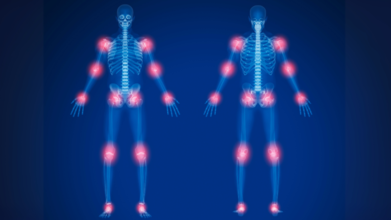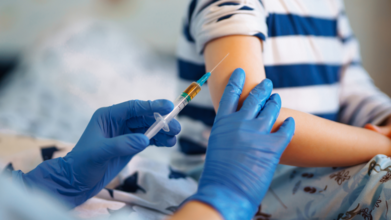- Health Conditions A-Z
- Health & Wellness
- Nutrition
- Fitness
- Health News
- Ayurveda
- Videos
- Medicine A-Z
- Parenting
- Web Stories
Friends, Happy Hormones And Detox: How Crying Can Boost Your Health

Benefits of crying (Credits: Freepik)
Crying is the human body's natural response. While it is often viewed as a sign of weakness, research has shown that it is actually beneficial for mental and physical health. Not only does it boost an individual's mood but also flushes out toxins of the body. Interestingly, humans are the only members of the animal kingdom who are capable of shedding tears.
But what actually is meant by crying?
Crying is defined as the act of shedding tears. However, not many know that these tears are categorized into three types. Basal tears, which are a protein-rich antibacterial liquid, help to keep the eyes moist every time a person blinks. In addition to that, there are reflex tears which are triggered by irritants such as winds, smoke or even chopping onions. The third type of tears are the emotional ones, which are triggered by feelings of joy, gloom, loneliness, and empathy amongst others.
What is released alongside the tears are endorphins, which eventually lift the mood of a person. Several studies by the American Psychological Association (APA) have shown that crying helps to reduce emotional distress and can provide a sense of relief and calm after a stressful event.
Surprisingly, crying can also act as a natural pain reliever. Tears produced during emotional crying contain a natural analgesic called leucine-enkephalin, which can help reduce pain and enhance feelings of well-being. This is akin to the "runner's high" but achieved through emotional release.
Moreover, crying can also strengthen social bonds and bolster community building. When we cry in front of others, it often elicits empathy and support from those around us. This emotional connection can enhance relationships and improve interpersonal relationships. It is viewed as an evolutionary strategy to bond with other human beings.
Notably, emotional tears, unlike those produced by chopping onions or irritants, contain higher levels of toxins, which eventually get flushed out when we cry. This detox helps improve overall health and contributes to a sense of physical and emotional well-being. Lastly, crying is known to elevate mood and improve mental health. This mood boost can be attributed to the release of endorphins, the brain's natural mood enhancers.
While there are numerous benefits, crying for a longer period of time could be a symptom of depression. In this case, it is advisable to seek a mental health professional.
6 Scary Symptoms ER Doctors Say You Should Never Brush Off

Credits: Canva
We have all been there, done that. Reaching out to Google every time we face slight discomfort sneezing, convinced that we have some serious disease. While not every ache or tickle means an emergency, some symptoms really do need urgent attention. According to ER doctors, there are a handful of red flags you should never brush off.
Here are six warning signs you should pay attention to immediately.
1. Chest Pain That Feels Super Heavy
We have all had heartburn after a cheesy pizza, but chest pain is not something to gamble with. Reports say crushing, pressure-like chest pain that radiates to your arm, jaw, or back is a huge red flag for a heart attack. Sometimes it comes with sweating, shortness of breath, or nausea. Even if you are young and otherwise healthy, do not assume it is just gas or stress. When in doubt, get checked out; it is always better to be told it is heartburn than to ignore a heart attack.
2. The Worst Headache of Your Life
Sure, headaches are common, but if you suddenly feel like someone is hammering your skull with no mercy, do not tough it out. According to the reports, a sudden, severe headache, especially if it is different from your usual migraines, could signal a brain aneurysm, bleeding, or other neurological emergency. Pair that with vision changes, weakness, or slurred speech, and you should be calling for help immediately.
3. Unexplained Shortness of Breath
Running up the stairs and wheezing like a deflating balloon is one thing. But struggling to breathe at rest or without any exertion? That is a whole different story. Experts say unexplained shortness of breath could point to conditions like blood clots in the lungs, asthma attacks, pneumonia, or even heart problems. If your chest feels tight, you are gasping for air, or your lips are turning blue, it is not something to “walk off”.
4. Sudden Weakness or Numbness in One Side of the Body
If you are holding something, and suddenly it slips right out of your hand because your arm has no feeling. Or half your face feels like it is melting. These are classic stroke symptoms, and ER doctors stress that time is everything. The quicker you get treatment, the higher the chances of recovery. Remember the acronym FAST: Face drooping, Arm weakness, Speech difficulty, Time to call emergency services. Do not wait it out hoping it will pass.
5. Uncontrolled Bleeding
A paper cut? No big deal. A deep cut that refuses to stop bleeding after 10 minutes of firm pressure? That is a medical emergency. According to the reports, that uncontrolled bleeding can mean a damaged artery or an underlying clotting disorder. If you are soaking through bandages or the blood will not stop, it is not something to ignore. Plus, losing too much blood too quickly can lead to shock and nobody wants to faint in their bathroom.
6. Severe Abdominal Pain That Comes Out of Nowhere
Stomach aches are often brushed off as bad food choices. But if you suddenly develop intense abdominal pain that does not go away, reports suggest it could be something much more serious, like appendicitis, gallstones, a perforated ulcer, or even an intestinal blockage. The kind of pain where you cannot stand up straight or move without wincing is not the “sleep it off” kind. Trust your gut, literally, and get checked.
Listen to Your Body’s Alarm Bells
Not every symptom is an emergency, but when your body loses it, it is trying to tell you something. ER doctors agree that ignoring these signs can lead to complications that are far harder to treat later.Japanese Scientists Discover Hidden Immune 'Hubs' That Could Cause Arthritis-Related Joint Damage

Credits: Canva
A team of researchers from Kyoto University, Japan, has uncovered hidden immune “hubs” that appear to play a critical role in driving joint damage in patients with rheumatoid arthritis (RA).
The breakthrough, published in Science Immunology, sheds light on why inflammation persists in many patients despite existing treatments and may pave the way for new therapies.
Understanding Rheumatoid Arthritis
Rheumatoid arthritis is an autoimmune disease that affects millions worldwide, causing painful swelling, stiffness, and damage in the joints. It occurs when the body’s immune system mistakenly attacks its own tissues.
While medications such as disease-modifying anti-rheumatic drugs (DMARDs) and biologics have improved outcomes, nearly one in three patients continues to respond poorly to current therapies. This new study provides an explanation for that treatment resistance.
Discovery of Immune Hubs
The Japanese team focused on a subset of immune cells known as peripheral helper T cells (Tph cells). Researchers discovered that Tph cells exist in two distinct forms: stem-like Tph cells and effector Tph cells.
The stem-like Tph cells were found residing inside small immune hubs known as tertiary lymphoid structures within inflamed joints. Inside these hubs, the stem-like cells multiply and activate B cells, which are responsible for producing antibodies.
Some of these stem-like Tph cells eventually mature into effector Tph cells, which leave the hubs and contribute directly to joint inflammation by interacting with other immune cells such as macrophages and killer T cells. This continuous supply of effector cells could be the reason inflammation continues in patients even after treatment.
A New Therapeutic Target
By pinpointing the root of the problem, the scientists believe treatment strategies could shift toward targeting these stem-like Tph cells.
“Because stem-like Tph cells can both self-renew and differentiate, they may represent a root cause of the disease,” said lead researcher Yuki Masuo of Kyoto University. Neutralizing or limiting the activity of these cells at their source could potentially reduce the cycle of inflammation and slow down joint damage.
Advanced Techniques Revealed the Mechanism
The team reached these findings using a cutting-edge approach called multi-omics, which combines multiple layers of biological data.
By analyzing immune cells from both inflamed joint tissues and blood samples of RA patients, they created a comprehensive picture of how Tph cells behave. The results showed that stem-like Tph cells predominantly live inside immune hubs where they maintain close contact with B cells.
To confirm their theory, researchers recreated the environment in the lab by growing stem-like Tph cells and B cells together. They found that this interaction not only helped Tph cells transform into effector cells but also activated B cells, further fueling the immune response.
Why This Matters
The study marks an important step in understanding why rheumatoid arthritis is so difficult to treat in some patients. By revealing the role of immune hubs, it provides a more detailed map of how chronic inflammation is sustained in joints. For patients who struggle with current medications, these insights could one day translate into therapies that are more precise and effective.
COVID-19 Shot Recommendations Children 6 Months to 2 Years Should Be Vaccinated, AAP Diverges From CDC Advice

(Credit - Canva)
The discourse surrounding vaccinations has been rampant in the past few years. Many people are questioning the validity of vaccines and why they need to have them. This becomes much more complicated when it involves children. Parents have expressed their concerns and whether their immune systems can handle vaccines. This is why we turn to recommendations by health organizations such as AAP and CDC, however, their new guidelines on the same are now clashing.
The American Academy of Pediatrics (AAP) has released new recommendations stating that all children ages 6 to 23 months should receive a COVID-19 vaccine. This guidance is part of the AAP's annual childhood immunization schedule and includes recommendations for COVID, flu, and RSV vaccines for those 18 and under. This advice from the AAP stands in contrast to recent guidance from federal health officials.
How Are These Different From Federal Guideline?
The AAP's recommendation comes after Health and Human Services Secretary Robert F. Kennedy Jr. announced that the Centers for Disease Control and Prevention (CDC) would no longer recommend the COVID-19 vaccine for healthy children. The CDC has since updated its guidance to a "shared clinical decision-making" model, which leaves the choice to vaccinate up to parents and their doctors. This difference in opinion highlights a growing disagreement between federal health officials and medical organizations on vaccine policy.
ABC news reports that AAP's president, Dr. Susan J. Kressly, stated that children between 6 and 23 months old are at the highest risk for severe COVID-19. She emphasized that the vaccine can protect these young children, many of whom were not exposed to the virus during the pandemic and therefore have no natural immunity. The AAP aims to provide clear and confident guidance to families who rely on them for medical advice, especially in a time of widespread misinformation.
How Does This Impact Vaccine Coverage?
While the AAP provides its own recommendations, insurance companies often follow the guidance of the CDC's vaccine panel. If the CDC's Advisory Committee on Immunization Practices (ACIP) does not recommend a vaccine, it could lead to families having to pay for the shots out-of-pocket. It could also mean the shots aren't covered by the Vaccines for Children (VFC) program, which provides free vaccines to eligible children. The AAP is in talks with insurance companies to ensure that vaccines remain accessible as a part of standard preventive care.
Has Vaccine Skepticism Affect People’s Health?
The world is seeing a worrying increase in diseases that were once rare because of vaccines. GAVI, vaccine alliance, explains that this is threatening decades of public health progress and putting millions of lives at risk. In places like the United States and Canada, vaccination rates are dropping, leading to a rise in cases of diseases like measles. This problem is largely driven by the spread of false information about vaccines.
The children in this study were born during or after the start of the COVID-19 pandemic, which caused major disruptions to routine medical care. To help fix this problem, doctors should check a child's vaccination history at every visit and strongly recommend the necessary shots. To increase vaccination rates and protect all children from preventable diseases, experts suggest:
- Making it easier to get vaccines by removing financial and access barriers.
- Fighting vaccine hesitancy and the spread of false information.
- Using tools like reminder systems and strong recommendations from doctors to encourage parents to get their children vaccinated.
© 2024 Bennett, Coleman & Company Limited

